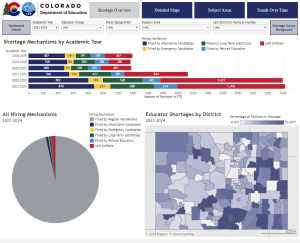CDE will be closed on Monday, September 1, for the Labor Day holiday.
You are here
Colorado's Educator Shortage Survey Results
Educator Shortage Survey Dashboard
Overview
As part of the strategic action plan developed in response to Colorado House Bill 17-1003, the Colorado Department of Education surveys the state’s school districts and Boards of Cooperative Educational Services (BOCES) about the employment of teachers, special services providers (SSPs), principals/assistant principals and paraprofessionals. These shortage data allow CDE to identify educator shortage areas across the state and report to the Colorado Legislature to inform decisions regarding support for recruiting and retaining educators. Results from the annual shortage survey are also used for federal educator shortage reporting.
Information regarding 2024-25 Educator Shortage Survey results, including the survey highlights, are available below. Summaries of prior year shortage survey results are also available on this page.
Shortage Survey Highlights
Detailed information about the number of positions filled by specific shortage mechanisms and unfilled positions are available through the interactive dashboard and/or in the downloadable Excel file.
State of the Educator Workforce: Vacant Positions
Vacant positions refer to any position that needed to be hired throughout the year. These can be filled through regular hiring mechanisms, shortage mechanisms, or may remain unfilled.
Teacher and special services provider (SSP) vacancies increased in 2024-25 compared to the previous year.
- Teacher Positions: 14.12% (7,792 positions) needed to be filled in 2024-25, up from 12.41% (6,911 positions) in 2023-24.
- SSP Positions:17.43% (7,840 positions) needed to be filled in 2024-25, up from 15.43% (7,685 positions) in 2023-24.
Conversely, principal and paraprofessional vacancies decreased in 2024-25 compared to the previous year.
- Principal Positions: 8.98% (345 positions) needed to be filled in 2024-25, down from 13.17% (499 positions) in 2023-24.
- Paraprofessional Positions: 11.45% (23,750 positions) needed to be filled in 2024-25, down from 15.11% (22,951 positions) in 2023-24.
State of Educator Shortage: Positions in Shortage
Statewide, the educator shortage decreased in 2024-25, with 2.91% of positions in shortage, compared to 3.53% in 2023-24 and 3.63% in 2022-23. This includes positions filled by shortage mechanisms and positions left unfilled.
- Non-Rural Areas: The shortage decreased to 1.94% of positions, down from 2.71% in 2023-24 and 2.84% in 2022-23.
- Rural and Small Rural Areas: The shortage remained steady at 6.92%, compared to 6.87% in 2023-24 and 6.95% in 2022-23.
Unfilled positions statewide fell to 0.68% of available positions in 2024-25, compared to 1.64% in 2023-24 and 1.90% in 2022-23.
- Rural and Small Rural Areas: Unfilled positions decreased to 0.76%, down from 1.53% in 2023-24 and 2.05% in 2022-23.
- Non-Rural Areas: Unfilled positions decreased to 0.63%, down from 1.55% in 2023-24 and 1.75% in 2022-23.
Statewide, SSPs saw the sharpest decrease in unfilled positions combined with an increase in positions filled by shortage mechanisms.
- SSP Unfilled Positions: Unfilled positions decreased with 0.96% left unfilled, down from 3.01% in 2023-24 and 3.62% in 2022-23.
- SSP Shortage Mechanisms: Positions filled using shortage mechanisms increased to 4.83%, up from 1.85% in 2023-24 and 2.1% in 2022-23. Most of these were filled by contracted services, reported in the “other mechanism” category of the shortage survey, a category that was not collected prior to 2024-25.
Federally Reported Educator Shortage Areas
Each year, the Educator Talent Division reports educator shortage areas to the US Department of Education in the Teacher Shortage Area report. The 2025-2026 list below is based on the 2024-2025 teacher shortage data and was approved by the Colorado State Board of Education in its June 2025 meeting. This list is updated annually in the summer for the following school year.
2025-2026 Statewide Shortage Areas
Teachers
- Agriculture and Natural Resources
- Business/Marketing
- Computer Science/Instructional Technology
- Culturally and Linguistically Diverse Education
- Dance
- Drama Theater Arts
- Early Childhood Education
- Early Childhood Special Education
- Elementary Education*
- English Language Arts*
- Family and Consumer Sciences
- Gifted Education
- Health Education
- Industrial Arts
- Mathematics*
- Music
- Physical Education*
- Science*
- Social Studies*
- Special Education Generalist*
- Special Education Specialist: Deaf and Hard of Hearing
- Special Education Specialist: Visually Impaired
- Visual Art
- World Languages.
Special Services Providers
- School Audiologist
- School Counselor*
- School Nurse
- School Occupational Therapist*
- School Orientation and Mobility Specialist
- School Physical Therapist
- School Psychologist*
- School Social Worker
- School Speech-Language Pathologist*
*Indicates the most critical shortages areas as determined by the percentage of total workforce left unfilled or utilizing shortage mechanisms
Educator Shortage Data for Prior Years
- In 2017, in response to Colorado House Bill 17-1003, Strategic Plan to Address Teacher Shortages, CDE and the Colorado Department of Higher Education (CDHE) collaboratively collected data to analyze the state’s educator shortage problem via a voluntary version of the survey to develop a strategic action plan. Voluntary Educator Shortage Survey results from the 2017-18 school year represent a sample of 47% of school districts and are therefore not comparable to survey results from subsequent school years, which represent all Colorado LEAs.
- View a summary of 2018-19 state-level educator shortage results with data provided separately for teaching and SSP positions and reported by teaching subject area, SSP category and district type (small rural, rural and non-rural). Excel file available here.
- View a summary of state-level educator shortage results for the years below that contain data provided separately for teacher, SSP, building leadership (principal/assistant principal) and paraprofessional positions. Data are also represented by teaching subject area, SSP type and rural designation (small rural, rural, or non-rural):



Connect With Us





